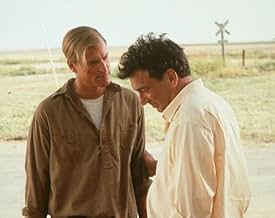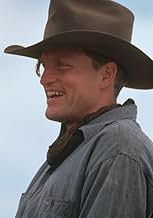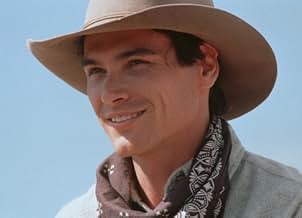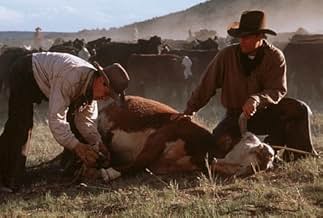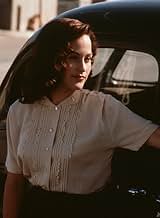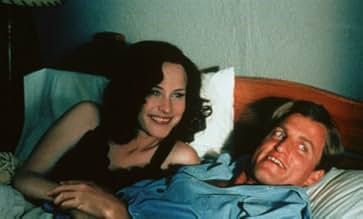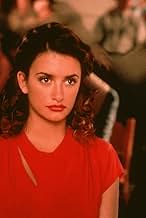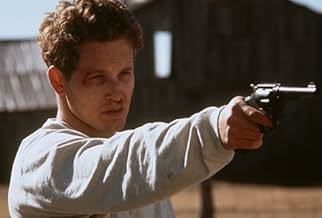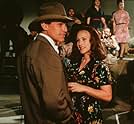The Hi-Lo Country
- 1998
- Tous publics
- 1h 54m
IMDb RATING
6.1/10
4.7K
YOUR RATING
Two cowboys have their friendship tested when they fall for the same girl.Two cowboys have their friendship tested when they fall for the same girl.Two cowboys have their friendship tested when they fall for the same girl.
- Awards
- 4 wins & 4 nominations total
Darren E. Burrows
- Billy Harte
- (as Darren Burrows)
- Director
- Writers
- All cast & crew
- Production, box office & more at IMDbPro
Featured reviews
I was surprised and disappointed to see this film only get a 6.0 in the database. I am giving it a 7 because Penelope Cruz, who I respect as an actress- amazing beauty aside- doesn't quite fit into this film. Otherwise, the directing from Stephen Frears, who has tried (it seems) as many genres as Howard Hawks, is solid. Billy Crudup, Patty Arquette and even Woody Harrelson (still want my $ back from NBK even though it's been a decade now!) is quite good in this. It is very hard to make Westerns these days, and I'm sure the box office from this film won't help. But, along with "Dead Man" and "Unforgiven," this film proves it can be done. Worth a look, especially for those of us ( a minority in my generation- GEN X) who still apprecaite the Western as a genre and as an art form.
The point of this exercise escapes me. Today, in 1999, there are probably two valid reasons for reviving a relic of a genre - to provide an old-fashioned, nostalgic, action-packed adventure, or to remould the Western in our age's image, to try to see what the form can say about us, our ideologies, and, most importantly, our relation to history. This film does neither.
On the one hand, it has many of the virtues of the traditional Western - lovingly bleached landscapes; a pompous, overwrought score; cattle runs; male bonding. But it has neither a compelling narrative drive, charismatic characters, nor a mythic sensibility.
On the deconstructive side, it seems to want to critique the problematic values of the West. The maverick rebel versus corporate muscle is, as has been pointed out, a theme worthy of Peckinpah, but its treatment lacks his romantic passion, violent sympathy, or dynamic self-pity.
The hero, Big Boy, is, according to some, a subject of the film's censure, but the only fault I can find in him is that he is probably impotent, and if that's supposed to be an iconoclastic weakness, than the filmmakers are being rather macho. So he's a bit wild and brutal; he's also loyal, dignified and amusing, and Woody Harrelson invests him with much charm. The rest of the characters, especially Pete, with his wretched narration(there are never voiceovers in Westerns!), are dull and unreal.
Jim Kitses has called the film a melodrama, and to an extent this is true - this is no quest narrative; there is no building a white US culture, no battle between the primitive and civilisation as one finds in the Fordian western. Much of the action focuses on the domestic. A recurring motif is barbed wire, suggesting that the characters are as corralled as the animals they steer, in a prison whose walls actively hurt.
The film is also faintly unusual in having a woman in a pivotal role, although Patricia Arquette is, as usual, quite appaling. However, without me revealing it, the coda betrays all this, reverts twofold to the old 'Print the legend' pack of lies, and still holds out faith in the 'Go west, young man' myth, exactly as they did in the old days.
Stephen Frears has been praised for adapting to the mores of the Western, but this is surely untrue. Photographing desert landscapes, however beautifully, does not make you a great Western filmmaker. You must have a critical apparatus, whether its through the use of montage, like Peckinpah, or though music and composition, like Leone. As a revisionist, Frears has actually regressed from these masters. There is very little of his stamp at all, none of the genre knowledge he showed in The Grifters, one of the great films of the 90s.
He is best at revealing claustrophobic and deceitful sexual tensions and power games between small groups of (often related) people. There are some excellent examples of this here, especially when the four lovers gather after the barroom brawl; there are also a few good scenes, and gorgeous silhouettes: but mostly the thing flounders in its own insecurity and reverence.
On the one hand, it has many of the virtues of the traditional Western - lovingly bleached landscapes; a pompous, overwrought score; cattle runs; male bonding. But it has neither a compelling narrative drive, charismatic characters, nor a mythic sensibility.
On the deconstructive side, it seems to want to critique the problematic values of the West. The maverick rebel versus corporate muscle is, as has been pointed out, a theme worthy of Peckinpah, but its treatment lacks his romantic passion, violent sympathy, or dynamic self-pity.
The hero, Big Boy, is, according to some, a subject of the film's censure, but the only fault I can find in him is that he is probably impotent, and if that's supposed to be an iconoclastic weakness, than the filmmakers are being rather macho. So he's a bit wild and brutal; he's also loyal, dignified and amusing, and Woody Harrelson invests him with much charm. The rest of the characters, especially Pete, with his wretched narration(there are never voiceovers in Westerns!), are dull and unreal.
Jim Kitses has called the film a melodrama, and to an extent this is true - this is no quest narrative; there is no building a white US culture, no battle between the primitive and civilisation as one finds in the Fordian western. Much of the action focuses on the domestic. A recurring motif is barbed wire, suggesting that the characters are as corralled as the animals they steer, in a prison whose walls actively hurt.
The film is also faintly unusual in having a woman in a pivotal role, although Patricia Arquette is, as usual, quite appaling. However, without me revealing it, the coda betrays all this, reverts twofold to the old 'Print the legend' pack of lies, and still holds out faith in the 'Go west, young man' myth, exactly as they did in the old days.
Stephen Frears has been praised for adapting to the mores of the Western, but this is surely untrue. Photographing desert landscapes, however beautifully, does not make you a great Western filmmaker. You must have a critical apparatus, whether its through the use of montage, like Peckinpah, or though music and composition, like Leone. As a revisionist, Frears has actually regressed from these masters. There is very little of his stamp at all, none of the genre knowledge he showed in The Grifters, one of the great films of the 90s.
He is best at revealing claustrophobic and deceitful sexual tensions and power games between small groups of (often related) people. There are some excellent examples of this here, especially when the four lovers gather after the barroom brawl; there are also a few good scenes, and gorgeous silhouettes: but mostly the thing flounders in its own insecurity and reverence.
Great to see a new western and this one was particularly good to look at: capturing the flat, wide western country with all its beauty and natural dangers and contrasting it nicely with the badly-lit, cramped and emotionally charged interior spaces of its bars, farmsteads and honky-tonks. Outside there might be sun, drought, wind and snow, all largely visited at nature's whim; inside there's all sorts of very human dangers, including: infidelity, cheating, financial and legal corruption, and witchcraft - which can all be largely seen as a breaking down of loyalty and trust. War, the demands of the market-place and changing times in general, are shown to have bought a dislocation to the traditional rural certainties of conduct and order; the same forces splitting both the community at large and individual families.
Ed Buscombe's masterly review in Sight and Sound articulated my own slight sense of disappointment with the film. He rightly saw that the character of Big Boy, as played by Woody Harrelson, fails to convince that he is worthy of the strength of love and loyalty that Pete and others feel for him. As Buscombe says, his antics too often subside into a charmless boorishness - contrast this say with Kristofferson's Billy the Kid for Peckinpah, whose behaviour is equally wild but we never doubt his basic goodness and accept the affection in which he is generally held.
The film's recreation of the1940s was very nicely done: with terrific locations and just enough of the right artefacts to suggest the period, rather than an over-dressed museum tableau. The film cleverly slips between that contemporary world and an oppositional timelessness in the unchanging rhythm of the cowboy's life. I liked the way the film's characters acknowledge the anachronistic effort required to follow the cowboy life in 1940s post war USA: "I hear you're having an old fashioned cattle drive" Mona says to Pete, and earlier when Pete suggests to Jim Ed Love, the cattle baron, that "people still drive their cattle to the railhead" he replies "only in the movies".
More than a nod then to Red River, with its fascination with the changing demands of the market place and the effects those changes bring to ranch and cowboy. At heart HiLo is not much more than a rather tacky melodrama but its still very watchable: its lovingly shot, it just about keeps the western mythology alive and it has some great songs. It also has good supporting performances from Billy Crudup (Pete), Patricia Arquette (Mona) and Rosaleen Linehan (Mrs Big Boy), in particular.
Ed Buscombe's masterly review in Sight and Sound articulated my own slight sense of disappointment with the film. He rightly saw that the character of Big Boy, as played by Woody Harrelson, fails to convince that he is worthy of the strength of love and loyalty that Pete and others feel for him. As Buscombe says, his antics too often subside into a charmless boorishness - contrast this say with Kristofferson's Billy the Kid for Peckinpah, whose behaviour is equally wild but we never doubt his basic goodness and accept the affection in which he is generally held.
The film's recreation of the1940s was very nicely done: with terrific locations and just enough of the right artefacts to suggest the period, rather than an over-dressed museum tableau. The film cleverly slips between that contemporary world and an oppositional timelessness in the unchanging rhythm of the cowboy's life. I liked the way the film's characters acknowledge the anachronistic effort required to follow the cowboy life in 1940s post war USA: "I hear you're having an old fashioned cattle drive" Mona says to Pete, and earlier when Pete suggests to Jim Ed Love, the cattle baron, that "people still drive their cattle to the railhead" he replies "only in the movies".
More than a nod then to Red River, with its fascination with the changing demands of the market place and the effects those changes bring to ranch and cowboy. At heart HiLo is not much more than a rather tacky melodrama but its still very watchable: its lovingly shot, it just about keeps the western mythology alive and it has some great songs. It also has good supporting performances from Billy Crudup (Pete), Patricia Arquette (Mona) and Rosaleen Linehan (Mrs Big Boy), in particular.
7807
Set in the late 1940s, The Hi-Lo Country is a strange mix of drama, romance, western, buddy movie and something that can be best described as an Americana version of Latin America's magical realism: there's even a witch telling the future, and her prophecy fulfills! The movie does not offer much in terms of action: it rather sets out to be a "slice-of-life" piece, taking a look both at the events and the changes occurring in all the lead characters. I can understand this kind of approach can be disliked by some viewers; still, I found this movie interesting and somewhat underrated (picked it one evening on the cable). If you like a movie that emphasizes the mood instead of the actual action and with a strong cast ensemble (watch for Northern Exposure's Darren Burrows!), this is for you. 7 out of 10.
The Hi-Lo Country has it all: male bonding, bar fights, passion and obsession. The characters reflect the brutality and the charm of old ways which refuse to die. Great performances by Woody Harrelson and the younger Billy Crudup who star as lifelong friends whose world made of land and cattle start changing under their feet after their return from World War II.
The Hi-Lo Country is an involving, intense and somewhat nostalgic western which tries to abandon traditional plot lines while using all the classic western cliches. Strongly advised to people who like some "melo" in their "drama".
The Hi-Lo Country is an involving, intense and somewhat nostalgic western which tries to abandon traditional plot lines while using all the classic western cliches. Strongly advised to people who like some "melo" in their "drama".
Did you know
- TriviaDirector Sam Peckinpah tried to get this movie produced for years, but unfortunately he died before he had the chance.
- GoofsA Coke vending machine is clearly labeled ten cents. In this part of the country in the late 1940s it would have been five cents. Around 1960 vending machines went to six cents, quite a novelty at the time, requiring two coins to get a Coke. It was later in the 1960s when vending machines finally went to ten cents.
- Quotes
Pete Calder: I once set out to kill a man. I took pleasure in the thought of his death.
- SoundtracksQue Chulos Ojos
Written by Francisco Cantu
Performed by Hermanas Ayala
Published by San Antonio Music Publishers, Inc.
- How long is The Hi-Lo Country?Powered by Alexa
Details
- Release date
- Countries of origin
- Official site
- Language
- Also known as
- İhtiras tomurcukları
- Filming locations
- Production companies
- See more company credits at IMDbPro
Box office
- Gross US & Canada
- $166,082
- Opening weekend US & Canada
- $17,712
- Jan 3, 1999
- Gross worldwide
- $166,082
- Runtime1 hour 54 minutes
- Sound mix
- Aspect ratio
- 2.35 : 1
Contribute to this page
Suggest an edit or add missing content




